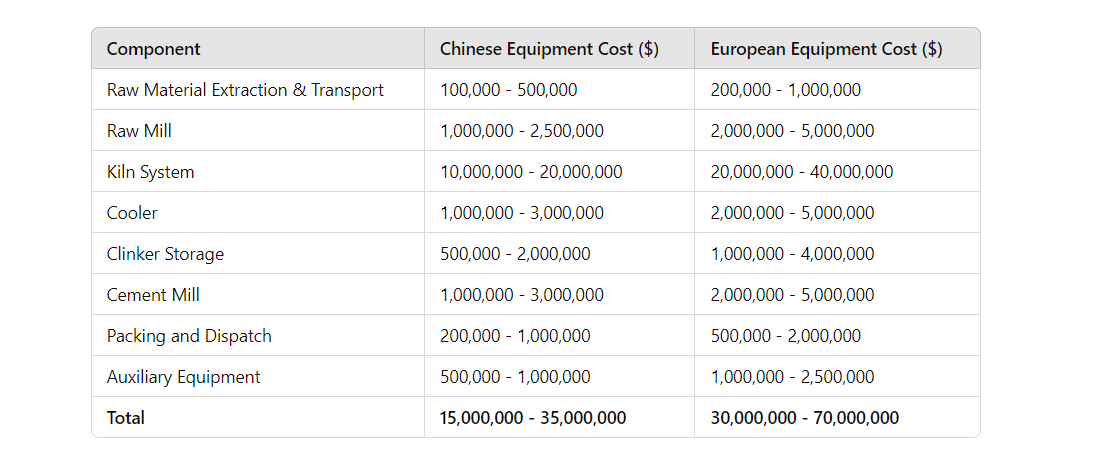Contents
The Comprehensive Guide to Cement Plant Costs: An In-Depth Look at Equipment, Workforce, and Material Costs

TO Download this post and all the books and excel sheets and my personal notes and presentations I collected about cement industry in the last 30 years click the below paypal link
Introduction
Setting up a cement plant involves numerous components and stages, each contributing significantly to the overall cost. This detailed guide will break down the costs associated with each component and stage of a cement factory, from raw material preparation to final packaging and distribution. Additionally, we will compare the costs of using Chinese and European equipment, providing examples of brands and models to give you a clear picture of what to expect financially.
Components of a Cement Plant
- Raw Material Extraction and Transportation
- Raw Mill
- Kiln System
- Cooler
- Clinker Storage
- Cement Mill
- Packing and Dispatch
- Auxiliary Equipment
Detailed Cost Breakdown
1. Raw Material Extraction and Transportation
This stage involves the extraction of raw materials like limestone, clay, and sand, and their transportation to the cement plant.
- Equipment: Excavators, dump trucks, and conveyor belts.
- Technical Specifications:
- Excavators: 35-50 tons capacity, 1.5-3.0 cubic meter bucket.
- Dump Trucks: 30-50 tons capacity.
- Conveyor Belts: 1-2 meter width, 200-500 meters length.
- Example Brands:
- Chinese: SANY (SY365H Excavator), XCMG (LW600KN Wheel Loader)
- European: Caterpillar (336F Excavator), Volvo (L150H Wheel Loader)
- Costs:
- Chinese: $100,000 – $500,000 for a fleet of equipment
- European: $200,000 – $1,000,000 for a fleet of equipment
2. Raw Mill
The raw mill is used to grind raw materials into “raw mix” during the manufacture of cement.
- Equipment: Ball mills, vertical roller mills.
- Technical Specifications:
- Ball Mills: 10-30 tons/hour capacity, 500-1500 kW motor power.
- Vertical Roller Mills: 20-50 tons/hour capacity, 1000-3000 kW motor power.
- Example Brands:
- Chinese: Sinoma (LM series Vertical Mill)
- European: FLSmidth (Atox Vertical Mill), Loesche (LM Vertical Roller Mill)
- Costs:
- Chinese: $1,000,000 – $2,500,000
- European: $2,000,000 – $5,000,000
3. Kiln System
The kiln is the heart of the cement plant, where the raw mix is transformed into clinker through heating.
- Equipment: Rotary kilns, preheaters, precalciners.
- Technical Specifications:
- Rotary Kilns: 3.5-6.2 meter diameter, 60-90 meter length, 2000-6000 tons/day capacity.
- Preheaters: 4-6 stages, 1000-3000 tons/day capacity.
- Precalciners: 1000-3000 tons/day capacity.
- Example Brands:
- Chinese: CITIC HIC (6.2x93m Rotary Kiln)
- European: FLSmidth (Rotax-2 Rotary Kiln), KHD (PYROFLOOR® Clinker Cooler)
- Costs:
- Chinese: $10,000,000 – $20,000,000
- European: $20,000,000 – $40,000,000
4. Cooler
The clinker cooler rapidly cools the hot clinker from the kiln.
- Equipment: Grate coolers, planetary coolers.
- Technical Specifications:
- Grate Coolers: 1000-6000 tons/day capacity.
- Planetary Coolers: 1000-3000 tons/day capacity.
- Example Brands:
- Chinese: Sinoma (Grate Cooler)
- European: FLSmidth (Cross-Bar® Cooler), IKN (Pendulum Cooler®)
- Costs:
- Chinese: $1,000,000 – $3,000,000
- European: $2,000,000 – $5,000,000
5. Clinker Storage
Clinker storage is essential for maintaining a buffer between the kiln and the finish mill.
- Equipment: Clinker silos, stacker-reclaimers.
- Technical Specifications:
- Clinker Silos: 10,000-50,000 tons capacity.
- Stacker-Reclaimers: 100-500 tons/hour capacity.
- Example Brands:
- Chinese: Sinoma (Circular Stacker-Reclaimer)
- European: Bedeschi (Stacker Reclaimer)
- Costs:
- Chinese: $500,000 – $2,000,000
- European: $1,000,000 – $4,000,000
6. Cement Mill
The cement mill grinds the clinker to a fine powder, which is then mixed with gypsum to form cement.
- Equipment: Ball mills, vertical roller mills.
- Technical Specifications:
- Ball Mills: 10-30 tons/hour capacity, 500-1500 kW motor power.
- Vertical Roller Mills: 20-50 tons/hour capacity, 1000-3000 kW motor power.
- Example Brands:
- Chinese: Sinoma (LM series Vertical Mill)
- European: FLSmidth (OK™ Mill), Loesche (LM Vertical Roller Mill)
- Costs:
- Chinese: $1,000,000 – $3,000,000
- European: $2,000,000 – $5,000,000
7. Packing and Dispatch
The final stage involves packing the cement and dispatching it to customers.
- Equipment: Rotary packers, truck loaders.
- Technical Specifications:
- Rotary Packers: 100-200 tons/hour capacity.
- Truck Loaders: 100-300 tons/hour capacity.
- Example Brands:
- Chinese: Haver & Boecker (Rotopacker)
- European: FLSmidth (Ventomatic® Rotary Packer)
- Costs:
- Chinese: $200,000 – $1,000,000
- European: $500,000 – $2,000,000
8. Auxiliary Equipment
This includes various equipment that supports the main plant operations, such as air compressors, water treatment plants, and power supply systems.
- Technical Specifications:
- Air Compressors: 500-3000 cubic meters/hour.
- Water Treatment Plants: 500-2000 cubic meters/day.
- Power Supply Systems: 1000-5000 kW capacity.
- Example Brands:
- Chinese: Kaeser (Air Compressor)
- European: Atlas Copco (Air Compressor)
- Costs:
- Chinese: $500,000 – $1,000,000
- European: $1,000,000 – $2,500,000
Workforce Costs
Workforce costs vary widely depending on the region and the scale of operations. Here’s a rough estimate:
- Chinese Equipment: Labor tends to be less expensive, with skilled workers costing around $15,000 – $30,000 per year.
- European Equipment: Labor costs are higher, with skilled workers costing around $30,000 – $60,000 per year.
Total Cost Comparison
To provide a clearer comparison, here is a summary table of the costs involved:
| Component | Chinese Equipment Cost ($) | European Equipment Cost ($) |
|---|---|---|
| Raw Material Extraction & Transport | 100,000 – 500,000 | 200,000 – 1,000,000 |
| Raw Mill | 1,000,000 – 2,500,000 | 2,000,000 – 5,000,000 |
| Kiln System | 10,000,000 – 20,000,000 | 20,000,000 – 40,000,000 |
| Cooler | 1,000,000 – 3,000,000 | 2,000,000 – 5,000,000 |
| Clinker Storage | 500,000 – 2,000,000 | 1,000,000 – 4,000,000 |
| Cement Mill | 1,000,000 – 3,000,000 | 2,000,000 – 5,000,000 |
| Packing and Dispatch | 200,000 – 1,000,000 | 500,000 – 2,000,000 |
| Auxiliary Equipment | 500,000 – 1,000,000 | 1,000,000 – 2,500,000 |
| Total | 15,000,000 – 35,000,000 | 30,000,000 – 70,000,000 |
Conclusion
Choosing between Chinese and European equipment depends on various factors including budget, quality, and long-term operational costs. While Chinese equipment is more cost-effective initially, European equipment often offers better efficiency and durability, potentially reducing long-term operational costs.
References
- FLSmidth Cement Equipment
- Sinoma International Engineering
- Loesche Vertical Mills
- CITIC Heavy Industries
- SANY Group
- Volvo Construction Equipment
- Atlas Copco Compressors
This comprehensive guide aims to provide a thorough understanding of the costs involved in setting up and running a cement plant, equipping you with the knowledge needed to make an informed decision.
TO Download this post and all the books and excel sheets and my personal notes and presentations I collected about cement industry in the last 30 years click the below paypal link
